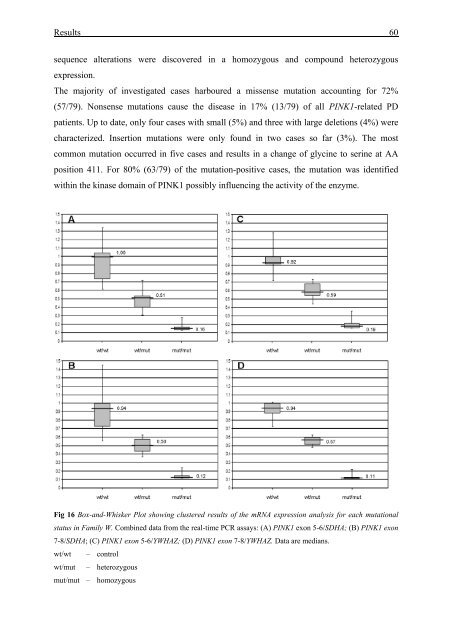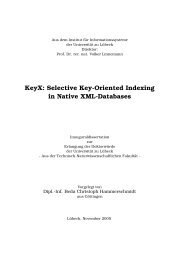Molecular characterisation of SGCE-associated myoclonus-dystonia ...
Molecular characterisation of SGCE-associated myoclonus-dystonia ...
Molecular characterisation of SGCE-associated myoclonus-dystonia ...
You also want an ePaper? Increase the reach of your titles
YUMPU automatically turns print PDFs into web optimized ePapers that Google loves.
Results 60<br />
sequence alterations were discovered in a homozygous and compound heterozygous<br />
expression.<br />
The majority <strong>of</strong> investigated cases harboured a missense mutation accounting for 72%<br />
(57/79). Nonsense mutations cause the disease in 17% (13/79) <strong>of</strong> all PINK1-related PD<br />
patients. Up to date, only four cases with small (5%) and three with large deletions (4%) were<br />
characterized. Insertion mutations were only found in two cases so far (3%). The most<br />
common mutation occurred in five cases and results in a change <strong>of</strong> glycine to serine at AA<br />
position 411. For 80% (63/79) <strong>of</strong> the mutation-positive cases, the mutation was identified<br />
within the kinase domain <strong>of</strong> PINK1 possibly influencing the activity <strong>of</strong> the enzyme.<br />
Fig 16 Box-and-Whisker Plot showing clustered results <strong>of</strong> the mRNA expression analysis for each mutational<br />
status in Family W. Combined data from the real-time PCR assays: (A) PINK1 exon 5-6/SDHA; (B) PINK1 exon<br />
7-8/SDHA; (C) PINK1 exon 5-6/YWHAZ; (D) PINK1 exon 7-8/YWHAZ. Data are medians.<br />
wt/wt – control<br />
wt/mut – heterozygous<br />
mut/mut – homozygous

















